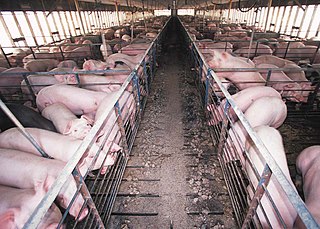“Meat is murder”, so the saying goes. But aside from the moral arguments, meat might be “murder” on the environment. It has been argued that meat production contributes to climate change, soil destruction, deforestation, overproduction of soy and corn and other monoculture feed crops, water (nitrate) pollution, and more. In discussions about the most obvious solutions to environmental problems caused by our food systems, the reduction of meat consumption is usually the first or second suggestion.
Meat production contributes to nitrogen pollution, primarily through Confined Animal Feeding Operations (or “CAFOs”). CAFOs can only by a stretch of imagination be considered “farms”—pretty much they are factories where the baselines of needs for growing animals are provided. CAFOs look like this:


Animals are packed into tight quarters, often such that they are subject to intensely unnatural disease pressures. Chickens are known to peck each other to death in such confinement, which is why it is common practice to “de-beak” chickens in CAFOs. Manure from animals concentrates in large quantities, forming a health danger to the animals and human workers, and a pollutant to local ecologies.
Notorious for ethical/animal rights violations (so much so that “Ag Gag” laws have been passed to penalize investigative reporters who enter such facilities to document atrocities), CAFOs are major buyers of grain and antibiotics, producers of toxic manure ponds, vectors for disease (not to mention absolutely horrible smells!), and sources of immense amounts of methane gas (emitted from concentrations of manure). In this way animal production has become a major contributor to climate change and environmental destruction.
The grains produced for animal consumption are converted, on average, very inefficiently. It is a basic rule of biology that energy is lost every time it converts forms: this means that as food moves “up the food chain” (from, say, plants to herbivores to carnivores) it loses orders of magnitude of useful energy. That cow, as it eats grain (which could’ve theoretically fed human beings directly), uses some of this energy to grow, live, survive, and only some of the remaining energy is converted into the animal’s flesh. Because we are concentrating feed through animals into protein before we consume them, we are essentially using food to grow less food.
Animals do not need to eat grains in order to grow; in fact, cattle are built for eating grass not grain, but are fed grain to fatten them more quickly. So there are other options for the production of animals as food (if you aren’t morally against the concept), and this will be the subject of future posts. But in the modern industrial system of animal production, CAFOs reign supreme. Even cattle raised as “grass-fed” are often “finished” (meaning, the last 6 months to a year of their lives) at a feedlot (aka a CAFO).
As mentioned, grazing animals like cattle can be a source of (or catalyst for) habitat degradation, soil loss, deforestation, water pollution, etc. So it’s not just CAFOs that are suspect: extensive (rather than intensive) production of animals can also be a problem. Recall the Loess Plateau grazers that contributed to soil erosion there. Grazing has also been responsible for desertification in large parts of the arid Western United States. Brazil was the classic case of damage through extensive animal grazing, where cattle quickly followed the frontier of rainforest deforestation, and huge fires set to the forest to clear it quickly were often traced back to animal production interests. These days, though, this is less the case in Brazil than deforestation due to soy production. This means that soy-reliant vegans are not necessarily on any (environmental) moral high ground here!
That said, it is important to recognize just how bad animal production can be, for the animals, for habitat and other living things, and for the environment at large.